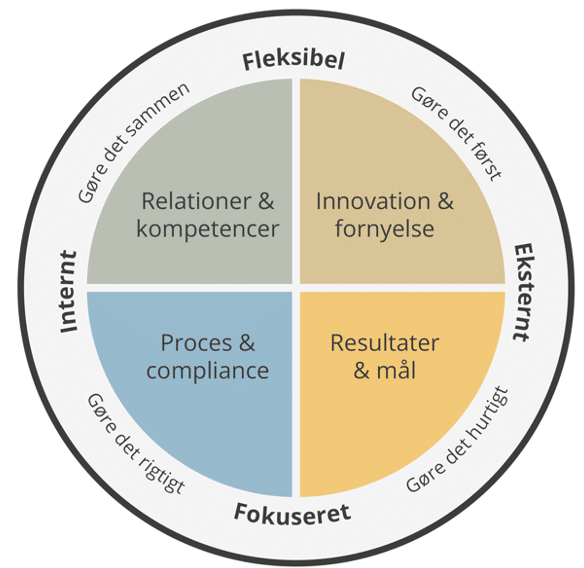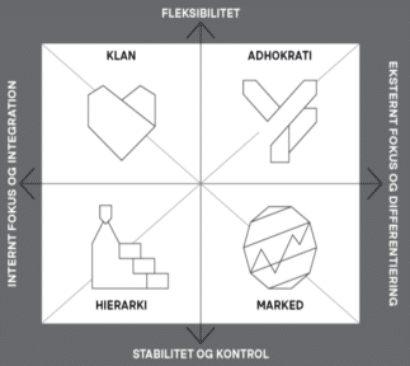"Culture eats strategy for breakfast". After decades of appearing on consultants' PowerPoint slides, Peter Drucker's famous quote has worn thin. But the quote has reached the cliché stage for a good reason. Because it has never been more true.
Research shows that culture affects performance, development and well-being. And research suggests that culture can be the biggest barrier to change and innovation. This may be why attention to organizational culture continues to grow in both private and public organizations. We see, for example, that Lars Fruergaard, CEO of Novo Nordisk, says that managers and employees in the company must dare to be vulnerable, show doubt and engage in dialog. According to Fruergaard, this helps to promote the innovation that drives Novo Nordisk forward. These values and leadership ideals help shape and legitimize behavior that influences the culture in a certain direction.
Another example is Søren Skou, the former CEO of Maersk, who decided to ditch the tie when he took up the position. He said it was a small thing, but also a signal to meet customers at eye level. They rarely wear ties and can therefore better reflect themselves in a less formal dress code. At the same time, the tie-less shirt signals a desire to create a culture where all employees feel represented and equal. The tie symbolized more than an article of clothing; it stood for a culture of conservative ideals. The elimination of the tie sends a signal about where Maersk wants to go as a company, and the culture must support that strategic intention.
Most managers probably dream of a culture that both promotes the completion of the core task and creates a high level of engagement and motivation among individuals. Especially at a time when continuous professional and personal development, strong communities and high social capital are important characteristics of an attractive workplace.
So how can you as a leader build and orchestrate a well-functioning and appropriate culture? The first step is to raise awareness of the existing culture. Unfortunately, we find that the leadership literature lacks concrete approaches on how to spot culture and influence it in a desired direction. Our ambition with this article is therefore to give you a tool to help you as a leader map current cultural traits and set goals to develop the culture in the desired direction. First, however, we want to ensure a bit of conceptual hygiene, as the concept of culture is used widely.
Want to be even better equipped to create a great feedback culture in the workplace?
In LEAD's leadership training, we give you concrete tools and models for creating a good feedback culture that can be put into practice.
This is a program for those who are new to the role of a manager and have not yet received basic management training.
Learn more about our research-based leadership training
Culture is 'the cultivated'
Culture means 'the cultivated' (while nature means 'the born'). Such a broad definition encompasses everything from national cultural traits to unwritten office rules. In this article, we focus on organizational culture. Every organization has its own culture, whether you choose to work with it or not. Culture is something that is at once complex and diffuse, yet directly and concretely influences behavior.
Culture is the behavioral patterns, embedded norms, routines and habits that employees and managers navigate on a daily basis. It's the common thread that runs through an organization or workplace and shapes how employees and managers behave. It's the way "we do things around here" - both consciously and unconsciously.
Culture is developed through the behaviors, values, basic assumptions and dominant narratives of all employees. But culture can be influenced and shaped. This is where leadership plays a significant role. Through both personal and formal authority, management influences culture. In popular terms, management shapes culture through "what you permit and what you promote".
The leader diagnoses the culture
One of the most useful tools for diagnosing an organizational culture is the OCAI, which stands for Organizational Culture Assessment Instrument. OCAI is based on the Competing Values Framework theory. So let's start with that.
The Competing Values Framework serves as a basic framework of understanding and points out that all organizations are faced with conflicting values and logics. Leadership therefore becomes a balancing act of navigating paradoxes and cross-pressures. Everyday life for leaders is not either-or, but always a balancing act between both-and. The theory helps to understand how to balance operations and development, relationships and results.
As a model, the Competing Values Framework is built around two axes. The vertical axis illustrates a continuum from 'Flexible' to 'Focused' and the horizontal axis from 'Inward-looking' to 'Outward-looking'. In total, there are four fields that are in opposition to each other in pairs, but at the same time, they are each other's prerequisites. As a leader, you need to meet organizational needs at both ends of the axes.
The way to deal with these conflicting demands is paradox management. Theoretically based on the Competing Values Framework, it's an approach where the leader navigates the competing values and needs that every organization holds. The goal is to become aware of what the organization assigns attention to and to develop a desired practice (and culture) for each of the four fields. By integrating conflicting considerations and consciously dialing up and down different categories of values and practices, leaders can increase the chances of developing a thriving culture.
The four fields are:
- Relationships & competencies: Here, management builds trust and unity in internal relationships. Collaboration is the focal point. Everyone should feel seen, heard and understood - and not least feel that they are part of the community with something valuable to offer. Recognition characterizes the dialogues and anything that strengthens team spirit is encouraged. People support each other and are committed to unlocking everyone's potential through a coaching and connective leadership style. In organizations where working with people is an important part of the core service (care, nursing, education, etc.), you'll typically find this quadrant to be the dominant cultural trait.
- Innovation & Renewal: This field is pronounced in newly founded organizations, institutions or departments characterized by a pioneering spirit. Management typically cultivates all contributions that develop the new and special things they want to be known for. This is reflected in the mission, vision and what you are good at in your core service. Concepts and methods are developed diligently. Ideas and experiments are welcome.
- Results & goals: The focus is on how the organization meets the requirements and expectations of the organization's services. Clear goals, implementation of new methods or reforms are high on the agenda. This cultural trait includes a drive for everyone to perform at their best. Key figures on operational goals and progress in development projects are diligently followed up on. The needs of citizens or customers drive value creation and the development of core services.
- Process & Compliance: This is where optimization, control and alignment are ramped up. Quality standards and fixed workflows emerge, and management focuses on ensuring clear roles and responsibilities, supported by procedures and guidelines - aimed at behavior or values. There must be no mistakes. Obviously, industries where lives are at stake or political attention is high are characterized by these cultural traits, which are referred to as hierarchy or bureaucracy (e.g. hospitals, police, defense, ministries, etc.) But they can also be organizations that have deep historical roots and where "nurturing" has grown strong.

A culture in balance
The Competing Values Framework is a fundamental framework that helps leaders translate and balance conflicting values and logics in culture. The basic point of the theory is that leaders need to master a broad repertoire of roles and behaviours that match the complexity and variation that the organization and its surroundings encounter the leader with. It is about being able to consciously relate to and coordinate joint efforts that correspond to the strategic or acute challenges that management faces.
The balance metaphor in leadership can also be applied to strategic work, which leaders often have a special responsibility to promote and succeed in. This balance depends on what the strategy calls for and how the culture inhibits or promotes the strategy. As we mentioned at the beginning, organizational culture can sometimes get in the way of strategy and its implementation. Culture describes the present, while strategy describes the (hopefully) future - where the organization is going in the long run. If you don't have a clear view of culture, strategy implementation becomes a bit like flying blind. This is where the Competing Values Framework provides a framework for understanding the existing culture against the strategy.
The theory also makes it possible to classify and clarify four different types of organizational culture that indicate how the organization acts, what it emphasizes and strives for, and what the fundamental values, assumptions and norms are. The four types of culture "fight" each other to shape employee assumptions and behaviors. In other words, there is no one cultural quadrant that is better than others; it's all about the organization's purpose and strategy. This is where tensions between strategy and organizational culture often arise and are important to be aware of.
In organizational cultures, there can often be a preference for "the way we do things around here" - embedded routines, norms and actions that shape how managers and employees behave. This means that there are often certain types or characteristics from the four organizational culture traits that are celebrated or exaggerated in the organization, while others are neglected or forgotten. This happens both consciously and unconsciously and can stifle strategic ambitions, especially if there is a big difference between the current organizational culture and what the strategy is trying to promote or focus on.
If you compare the organizational culture to the strategy and what it specifically requires and calls for, it becomes possible to identify which cultural traits inhibit and promote the strategic objectives and values. This makes it possible to consider what needs to be maintained, reduced or developed in order to succeed with strategy implementation.
Let's explore how to uncover and work with culture in relation to strategy implementation, among other things.
Four cultural traits
The OCAI analysis tool diagnoses organizational culture and is based on the theory of the Competing Values Framework. The OCAI tool has identified four archetypal cultural traits in organizations.
In the top left quadrant is the Clan cultural trait. This is a distinct "we culture" where learning, collaboration, commitment and well-being are keywords, while the leadership style is typically supportive, coaching and guiding.
On the right is Adhocracy, a culture characterized by fast and creative ways of adapting to the demands and opportunities of the outside world. The leadership style is strategic, visionary, exploratory and innovative.
Down a notch comes Market, which focuses on stability, external attention and differentiation. You concentrate on the core task and set goals and ambitions. Key words here are competition, goal achievement, high quality and satisfied users. It is stimulated by a leadership style that challenges, delegates, decides and is persistent.
In the last quadrant is Hierarchy with internal focus, integration, stability and control. Key words are safe operations, quality control, documentation, standards and compliance. The management style is therefore characterized by clarity, order and efficiency through consistency.
The four cultural traits are neither unilaterally good nor bad, although everyone has their own preference for certain quadrants. Instead, the cultural traits should be viewed in relation to the core function and context of the organization. In politically driven organizations, there is a need for accountability and a focus on safe operations. Therefore, many agencies and ministries will probably belong in the hierarchy culture trait. Conversely, small and medium-sized tech companies will be constrained by the uniformity and control of hierarchy. They are likely to be more innovative and responsive when new opportunities arise in the market.

When the dominant cultural trait regresses
Sometimes cultural traits become too strong. Too dominant. In this case, the cultural trait is said to regress. In short, it means that there is too much of a good thing.
In the Klan cultural trait, this can manifest itself in a sudden lack of room for dissent. Employees and managers keep silent and suppress ideas to remain part of the "happy family".
In the Adhocracy, there is no longer room to commit to a common agenda. You can end up with an individualistic culture where people only solve their own ad hoc tasks.
When the Market culture trait regresses, the competitive culture often takes over. This can lead to internal discord and metrics that clearly show an A and B team among employees.
In a regressed hierarchy, you risk ending up in a deadlocked organization where no one dares to make decisions or take even the slightest risk. This means that formal leadership is crucial to decisions and actions.
In the event that culture regresses, it's important to take it seriously. As mentioned, managing culture is about "what you permit and what you promote". If management allows the dark side of a clan culture, for example, it slowly becomes legitimate to dig ditches between "us and them".
How to get started
The Competing Values Framework and the OCAI analysis can be used as a starting point to uncover your organizational culture - either locally in the department or area or across the entire organization.
The first step is to identify and understand your own culture. This can be done by presenting the Competing Values Framework and the four quadrants. Then, as a team or area, you can discuss which cultural traits from the four quadrants are particularly evident or dominant in your company, both positively and negatively. You can either have an open discussion or rate the different cultural traits on a scale from 1 to 5, which measures how evident they are in your company. The OCAI questionnaire can also be used to gain a more quantitative understanding of your current and desired culture. The tools don't cover all the nuances, but they do have the strength of getting the dialog started (well). We therefore always recommend managers to invite employees and colleagues into the reflections on culture. This creates a shared and visual overview of the current culture, which can be the starting point for working purposefully with culture.
The next step is to map the desired culture. Often this will be against goals, objectives or strategy. Once this is done, the focus is on identifying differences in the existing and desired culture in order to clarify which actions, behavioral changes and initiatives will pull the culture in the desired direction. Questions such as "What do we need to do to nurture the culture we want to strengthen?" or "What do we need to do to reduce the culture that is developing in an inappropriate direction?" can be fruitful questions to ask. A keen eye for the existing culture can allow you to rise above it and explore together what it takes to push the organization in the desired direction.
In conclusion, we would like to emphasize that working with culture is largely about what you shine a light on, what behavior you recognize and support, and what behavior you allow as a leader. And not least that working with culture is rarely an end in itself, but rather an underestimated effort to succeed in realizing strategic initiatives, creating better results, increasing well-being or promoting development.




